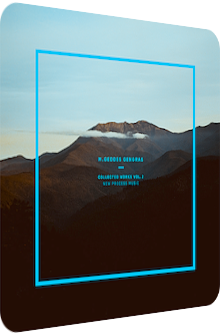
M. Geddes Gengras
Collected Works, Vol. 2:
New Process Music
2014
After the rubicund release comes the glaucous foil: when Los Angeles-based synthesist M. Geddes Gengras delivers his compendium Collected Works, Vol. 1: The Moog Years (2013) to Mexico City-based Umor Rex Records, the album is well regarded by the press, fans of the label and of course followers of Gengras’ fluoroscopic trademark mélange of stardust jitters, stereo-panned Moog cannelures and Space-Age sanctuaries. Now the artist is back with the second volume of his anthology. Consequentially called Collected Works, Vol. 2: New Process Music, it is released in October 2014 on the same label in a limited edition of blue vinyl. The album can be streamed and purchased at Bandcamp as usual. This time, the Moog synth stays out of the affair. Created between 2011 and 2012 with anything but a small eurorack synth and Magnavox tape echo, the result is astonishingly alluvial and dense. There is acidity sprayed onto the sceneries, but it is less harsh – let alone toxic – and more vibrant, with the lenticular grain and cloudlets of bursts serving as energetic counterpoints to the highly melodious punctilio. Collected Works, Vol. 2: New Process Music is a retrofuturistic New Age synthorama which happens to tightly fit into the overall aesthetics of Umor Rex, a label which shuttles between Glitch and Drone more often than not. All genre markers aside, said compatibility of M. Geddes Gengras’ archival arcanum with Umor Rex is not to be taken for granted: when the label picked up volume 1 aka the red edition, little did we know that there was a completed work in the pipeline that could see a release so soon. Sure, when there’s a volume 1, there must at least be a volume 2, but we thought that about The Prodigy’s Dirtchamber Sessions Vol. 1 (1999) as well, and look where that got us to. Gengras delivers an album that could be described as a tohubohu indeed. But there’s eclectic beauty in them splinted corridors.

Umor Rex's designer Daniel Castrejón even makes ice-blue look vivacious.
Pure is the ever-important opener of M. Geddes Gengras’ second collection, making the listener aware of the things to come, letting him or her test the water. Almost literally so, the mellow streamlet is extra-tangible when it moves from its pluvial static noise peritoneum over acidic blips agglutinated to low frequency protrusions until the endpoint of this ride leads to mucous metallics in potassium. Amalgamating accidental Rave splinters with interstitial sinecures, the synthesist makes it seem so easy. Said process is iterated throughout the album: the eight minutes long wind tunnel Slider is an eminently plinking staccato fusillade whose fibrillar modulation oscillates amidst mercurial scrimshaw artifacts, lanthanoid brakes and crystalline cyber capsules. Even though no beat is ever dropped, the rhythmic piece remains energetic and on the razor’s edge, feeling cold and dewy at the same time by annihilating the threatening hoarfrost via gyring anhydrides. The result is mercilessly retrosternal, ostensibly for the purpose of becoming the primary nerve stimulator. Airy and aqueous, this viridian veil eventually vanishes in order to make room for Ricochet, a wonderfully nebulous soundscape whose eclectic title-related ascription does not delineate the blurred/desiccate duality in its entirety; Gengras first caulks the cuckoo clock flowerage with the aid of stokehold drones, but later lets these bustling mica percolate and trickle on their own. The backdrop only comprises of a thin caproic ligament, though the contemplative ambience is never able to tame the pointillistic tachycardia in the limelight.
M. Geddes Gengras makes it clear that this work is very bubbly indeed and consequentially won’t shy away from the arpeggiated turmoil. This doesn’t mean that he isn’t willed to domesticate the Glitch-heavy bedlam in order to feign equanimity. Glass Dance is such a symmetrical yet selective piece: its first part is awash with grizzly calcium superfluids that drone soothingly along whereas the second part returns to the hexangular corkscrew fluke. The sine decortication is as vitreous as its title promises, and where there’s glass there’s slivers and splinters, hence the occasionally harsh bursts that give the diaphanous glow a rougher edge. The centerpiece of the album is called The Last Time We Were Here. Clocking in at nine minutes, the arrangement not only carries a title that is supposedly open to scrutiny, it is also a large tank whose titration process withdraws the liquedous molecules out of their fluidity. Launching as an oceanic trench with seamount blebs, reverberated bubbles and gorgeous water aureoles that drone in the distance, the composition gets more convulsive the drier the scenery becomes. After approximately three minutes, M. Geddes Gengras operates the water level sensor and creates a clandestine cavern with peculiarly piercing sapphire cotyledons, syrinx patterns and an aggrandizing chromaticity. What a bleepfest!
In what could be called an altered process, the synthesist from Los Angeles soon presents a short segue called Relation, and it is here where simultaneity leads to harmony indeed, for the dilute diorama is merged with the rioting reticulation of feisty fluoroborate. Rivers resembling electric guitars, sky-high machineries of the 60’s that emanate saccharified particles and flecks as well as processed cesspool bass bumps unite in a comparatively laid-back arena. Reciprocating between silvery incandescence and annealed saffron glows, the concomitance of elbowing sine tones and transfiguring superimpositions thereof is one definite highlight of this album. Keeping the tone of these cross-fading entities, the title-lending New Process is more of a thiazide than a caffeine dob. Instead of klaxon pulses, the vesiculating tones are raspier and more raucous, but also dun-colored and toned down enough to not be mistaken for evocative rascals. The serpentine twists and turns are closer to each other now, their leeway narrowed down, making room for the finale Pure (Reprise), the self-explanatory encore to the album’s kick-off. The melodic kaleidoscope remains the same, but the surface structures are infinitesimally more gelid and therefore less incisive, making this the farinaceous endpoint to an aquatic reign of carbon dioxide resonations, coal dust explosions and tetrachloride nanotubes… in aural form, naturally.
Collected Works, Vol. 2: New Process Music is a polyfoil work supercharged with a quilting of dots, ornaments and contretemps that are augmented in order to become fully blown-out thunderstorms. M. Geddes Gengras’ modular molecules serve as internecine plasticizers by cajoling their ways into the ears where their viscosity works as expected. This is one ebullient volume, everything is in constant motion, there is rarely a moment to reflect, let alone an epiphanic circumambience that breaks the glittering zoetrope. The eight tracks are bursting at the seams, blinding and dazzling the bystander with their energetic luminosity. A bubbly cauldron that could serve as the antagonist to the artist’s liminal New Age majesty as embroidered in Collected Works, Vol. 1: The Moog Years, the serration between Drone and Glitch is less vanillarific on the second volume… purposely so, I presume. There is not one single lavabo to look over the staccato photometry, every jitter, spark and wisp escapes, absconds, appends, permutes and rearranges the physiognomy. Melodies are few and far between, but such instances might be mistaken for partially euphonious tone sequences when it is actually the cascading cataracts of coruscation that leave a lasting impression. The surfaces and patterns, the textures and complexions are the real sovereigns of this album. When asked to describe New Process Music in one word only – which, as you can see, is not exactly my forte – I’d go for pulsation. Or tumult. Followers of both the label and the artist can pick up the second volume without a hitch. Just be aware of the bewildering but enlivening situation of listening to an album without beats that is nonetheless unbelievably variegating and vivifying.
Further listening and reading:
- You can purchase and stream Collected Works, Vol. 2: New Process Music at Bandcamp.
- Tweet it like Beckham: @mgeddesgengras & @UmorRex.
Ambient Review 392: M. Geddes Gengras – Collected Works, Vol. 2: New Process Music (2014). Originally published on Nov. 19, 2014 at AmbientExotica.com.
